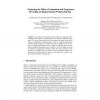Free Online Productivity Tools
i2Speak
i2Symbol
i2OCR
iTex2Img
iWeb2Print
iWeb2Shot
i2Type
iPdf2Split
iPdf2Merge
i2Bopomofo
i2Arabic
i2Style
i2Image
i2PDF
iLatex2Rtf
Sci2ools
DIAGRAMS
2006
Springer
2006
Springer
Exploring the Effect of Animation and Progressive Revealing on Diagrammatic Problem Solving
We conducted eye-tracking studies of subjects solving the problem of finding shortest paths in a graph using a known procedure (Dijkstra's algorithm). The goal of these studies was to investigate how people reason about and solve graphically presented problems. First, we compared performance when the graphical display was animated to when the display was static. Second, we compared performance when the display was initially sparse, with detailed information being progressively revealed, to when the display presented all information simultaneously. Results suggest that while animation of the procedure or algorithm does not improve accuracy, animation coupled with progressively revealing objects of interest on the display does improve accuracy and other measures of performance.
Artificial Intelligence | DIAGRAMS 2006 | Dijkstra's Algorithm | Eye-tracking Studies | Shortest Paths |
| Added | 22 Aug 2010 |
| Updated | 22 Aug 2010 |
| Type | Conference |
| Year | 2006 |
| Where | DIAGRAMS |
| Authors | Daesub Yoon, N. Hari Narayanan, SooCheol Lee, Oh-Cheon Kwon |
Comments (0)

